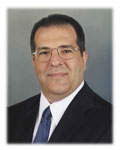|
 Jay Lieberman,
Jay Lieberman,
DPM, FACFAS
|
The navicular is the last bone in the tarsus to ossify (3 years of age). It is interposed between the head of the talus proximally and the three cuneiforms distally. The medial surface serves as one of the primary attachments of the tibialis posterior, and it can be felt through the adjacent skin.
When the medial surface of the navicular is enlarged, it can cause irritation in closed toe box shoes. The curved ridge under an enlarged navicular often makes it difficult to comfortably wear orthotic devices. Older texts suggested that an enlarged navicular resulted in an abnormal insertion of the posterior tibial tendon. It was believed that surgically removing the prominence and reorienting the tendon�s insertion could be done as an isolated procedure for longitudinal arch correction (Kidner 1929-1933).
Today this procedure is done predominantly to reduce the prominent bone and concomitantly retain physiologic tension of the posterior tibial tendon. Some surgeons believe it is not necessary to cinch up the tendon because there is a secondary attachment into the plantar cuneiforms and the lesser metatarsals.
Most surgeons today believe the Kidner procedure to be an adjunct to other flatfoot procedures (i.e. Evans, Koutogiannis, Subtalar Arthroereisis).
|
|
|
|
Pre op Flexible Collapsing Pes Plano
Valgus Deformity with Os Tibiale Externum |
Post Op AP with Kidner Procedure and MBA Arthroereisis � Talo navicular articulation improved |
An accessory navicular is also known as an Os Tibialis Externum, Os Navicular, Prehallux, and Gorilloid Navicular.
Three distinct types of accessory navicular bones have been described:
- a small, round separate ossicle imbedded within the posterior tibial tendon (type 1);
- a larger, triangular ossification centre adjacent to the navicular tuberosity and connected by a synchondrosis (type 2); and
- an enlarged medial horn of the navicular itself, called a cornuate navicular (type 3).1
Here are a few examples from the Lieberman Files:
|
 |
Gorilloid Navicular |
Large Os Tibiale Externum |
Accessory Navicular
|
|
Pre Op Accessory Navicular AP |
Pre Op Accessory Navicular Lateral |
| The patient’s symptoms were compatible with an injury to the cartilaginous attachment to the main body of the navicular. The accessory bone was removed and the posterior tibial tendon was sutured to the spring ligament plantarly. |
|
|
Post Op |
|
|
Enlarged Navicular with Os Tibialis Externum |
The enlargement was removed along with the accessory bone. The posterior tibial tendon was anchored to the main body of the navicular |
|
|
A classic Os Tibiali Externum
The medial deviation of the talar head also suggests a flatfoot. This would warrant a secondary and possibly third procedure.
|
Enlarged Navicular with Os Tibialis Externum |
|
|
Accessory Navicular |
Notice anterior advancement of the cyma line |
|
|
Accessory Navicular Surgically Removed with Arthroereisis in Place |
Postop lateral with arthroresis in place and normal cyma line. |
Residency question of the week. "What is wrong with these x-rays?"
Answer: The Talus and Navicular are coalesced into one bone.
References:
- Bernaerts A, Vanhoenacker FM, Van de Perre S, De Schepper AM, Parizel PM. Accessory navicular bone: not such a normal variant. JBR-BTR. 2004 Sep-Oct;87(5):250-2
Get a steady stream of all the NEW PRESENT Podiatry
eLearning by becoming our Facebook Fan.
Effective eLearning and a Colleague Network await you.
|

|
|
|
|
Integra LifeSciences, a world leader in medical devices, is dedicated to limiting uncertainty for surgeons, so they can concentrate on providing the best patient care. Integra offers innovative solutions in orthopedics, neurosurgery, spine, reconstructive and general surgery.
Integra Products
Why Integra is dedicated to limiting uncertainty for the busiest surgeon
Surgeons don't have a minute to waste. They navigate a world of uncertainty while making thousands of decision every day. These decisions directly affect patients - and surgeons. Integra knows this. By limiting uncertainty, we promise to do our part so that busy surgeons can continue to make the right decisions with confidence, and focus on what is most important.
|
|
|
|
|